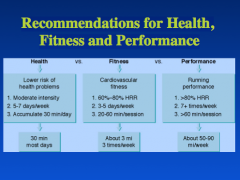![]()
![]()
![]()
Use LEFT and RIGHT arrow keys to navigate between flashcards;
Use UP and DOWN arrow keys to flip the card;
H to show hint;
A reads text to speech;
31 Cards in this Set
- Front
- Back
|
more activity is associated w/ lower rates of the following: |
-all cause mortality -cardiovascular disease -Type 2 diabetes -Total Fat -colon and breast cancer -osteoporosis |
|
|
physical activity improves the following but without evidence of dose responses:
|
-blood pressure -glucose control in type 2 diabetes -bood lipids -abdominal and visceral fat -depression -anxiety -independent living in older adults |
|
|
RESPONSES TO PHYSICAL ACTIVITY -improvements occur with one or several exercises
|
acute responses
|
|
|
RESPONSES TO PHYSICAL ACTIVITY -benefits occur early and plateall |
rapid responses
|
|
|
RESPONSES TO PHYSICAL ACTIVITY -gains are made continuously over time
|
linear responses
|
|
|
RESPONSES TO PHYSICAL ACTIVITY -improvements occur after weeks |
delayed responses
|
|
|
most important part of exercise prescription, SETS TONE, mission statement |
GOAL
|
|
|
type of exercise to be performed aerobic vs. Anaerobic, performance vs. Fitness |
MODE
|
|
|
How Hard ? Energy Expenditure, Heart Rate (direct vs Indirect) METS |
INTENSITY |
|
|
How long ? How many mins…secs..miles..laps.. |
DURATION
|
|
|
How often the exercise is done |
FREQUENCY |
|
|
Target Heart Rate (DIRECT) |
graded exercise test Linear plot HR vs VO2 |
|
|
Target Heart Rate (INDIRECT) |
MAX HR * % interested in
Heart Rate Reserve (HRR) |
|
|
METS |
1 MET =3.5 ml*kg-1*min-1 basal metabolic rate
|
|
|
*REMEMBER GRAPH* |

|
|
|
What do you do while exercising in heat ? |
-Know symptoms of heat illness and how to deal with them. - Exercise during the cooler parts of the day. -increase exposure to heat to safely acclimatize over 7 to 10 days. -Drink water before, during, and after exercise and weigh in each day to monitor hydration. -Wear only shorts and a tank top to expose as much skin as possible. -Use a strong sunblock -Take HR measurements during the activity and reduce exercise intensity to stay in the THR zone. |
|
|
ROLE OF RESISTANCE TRAINING (traditional) |
enhance sports performance, and increase muscle size |
|
|
ROLE OF RESISTANCE TRAINING (current) |
enhance health and fitness parameters in previously untrained people - glucose metabolism -management of body composition
|
|
|
principles of training: maximizing effectiveness of RT Programs (progression) |
manipulating program variables to continually increase training stimulus over time |
|
|
principles of training: maximizing effectiveness of RT Programs (regularity) |
training must occur on a regular basis because adaptations cannot be stored |
|
|
principles of training: maximizing effectiveness of RT Programs (overload) |
generally achieved by increasing intensity, total reps, repetition speed, rest period, type of exercise, training volume |
|
|
principles of training: maximizing effectiveness of RT Programs (specificity) SAID |
the most effective programs target specific muscle groups and actions and energy systems |
|
|
CONSIDERATIONS 4 PROGRAM DESIGN health status |
include previous training status, injuries, known disease, personal goals |
|
|
CONSIDERATIONS 4 PROGRAM DESIGN Fitness level |
training age initial program is simple advanced programs can be quite complex |
|
|
CONSIDERATIONS 4 PROGRAM DESIGN training goals |
short term long term use prior evaluations and personal goals -establish realistic goals to avoid discouragement or poor adherence |
|
|
principle of training |
maximizing effectiveness of resistance training programs |
|
|
Types of resistance training (Isometrics) |
increase in strength is limited to joint angle of training -more common in clinical settings
|
|
|
Types of resistance training (DCER)-dynamic constant external resistance
lifting is _______ lowering is ________ concentric or eccentric |
lifting (concentric) lowering (eccentric) phase tension exerted by a muscle concentrically varies throughout the ROM, but external load is constant |
|
|
Types of resistance training (DCER)-dynamic constant external resistance the external load is _____ |
constant |
|
|
Types of resistance training (isokinetics) |
muscular actions at constant velocity strength gains specific to velocity of training |
|
|
Types of resistance training (plyometrics) |
Rapid stretch (eccentric) shortening (concentric) action Explosive jumping, skipping, hopping, throwing Consider limiting plyometric training to those with established strength base 6 to 10 reps 2 days/week on nonconsecutive days |

